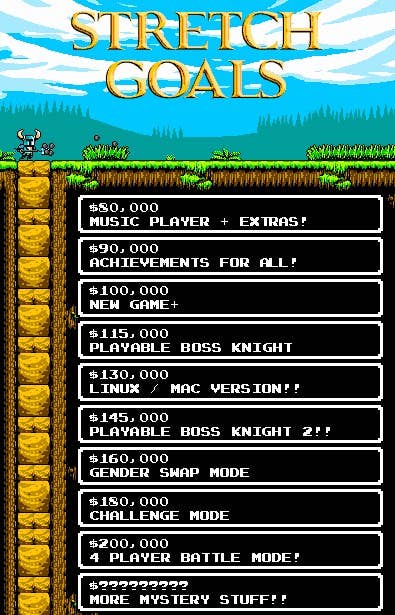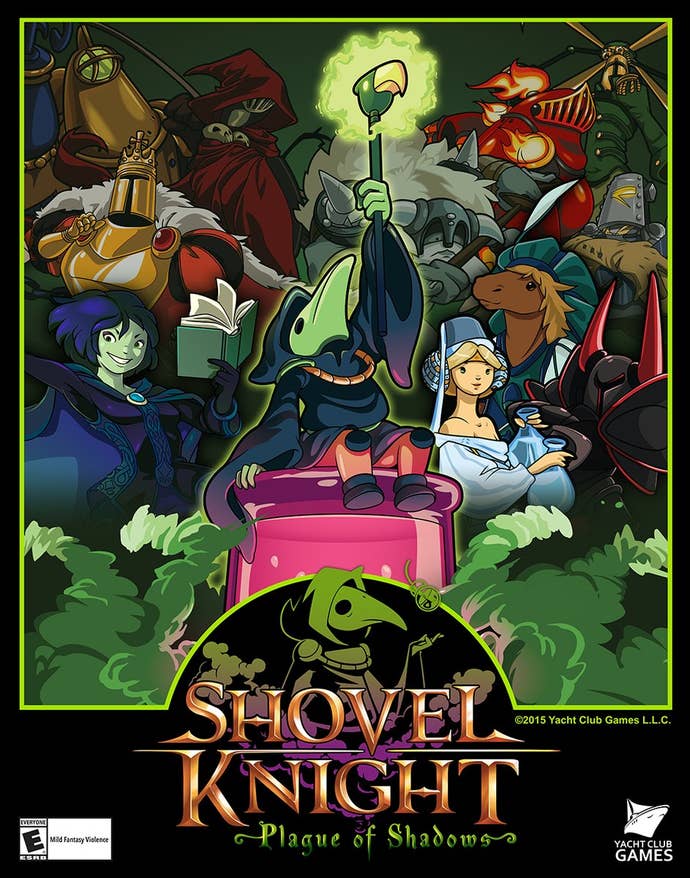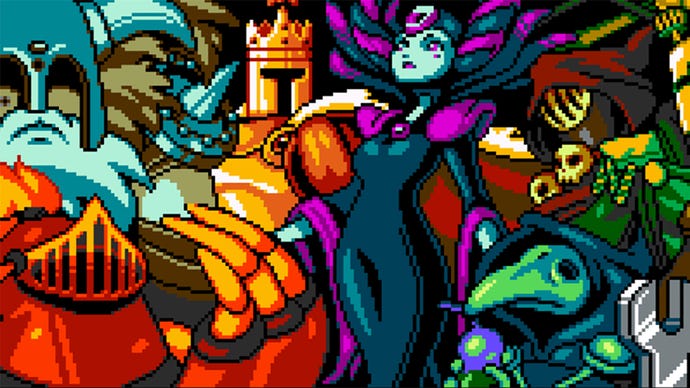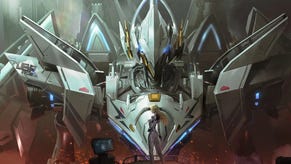How Shovel Knight: Treasure Trove Went From Minor DLC to a Collection Built to Last
Yacht Club Games recounts the evolution of Shovel Knight's ambitious collection.
This article first appeared on USgamer, a partner publication of VG247. Some content, such as this article, has been migrated to VG247 for posterity after USgamer's closure - but it has not been edited or further vetted by the VG247 team.
Editor's Note: This piece is a part of a series by Yacht Club Games looking back on the development of Shovel Knight: Treasure Trove and Specter of Torment. As we're fans of the series ourselves, we were happy to let them run it here on USgamer as a guest post. Stay tuned next week for a fuller inside look at the development of Specter of Torment as we prepare for the launch of King of Cards.
Gather around, curious collectors! Today, we thought it’d be fun to recount the all-encompassing journey of Shovel Knight's development. Let's explore how it all began, and how our original vision evolved into a 6 year development, producing five games in five years forming the multi-game collection known as Shovel Knight: Treasure Trove.
A Little Kick
Shovel Knight, as you may know, began its life on Kickstarter way back in 2013. It was to be developed by our newly formed game studio, Yacht Club Games. While our small team had developed games together in the past, Shovel Knight would be our debut as a fledgling company. We wanted to develop the game ourselves, so we pitched a game about a little knight on a big quest.

The Kickstarter campaign itself was full of ups and downs. A steady start, a trip to PAX, some stalls... but then it really started to take off. Our funding goal of $75,000 was met! Once a video game Kickstarter surpasses its initial funding goal, it is customary to unfurl a bunch of Stretch Goals. These are features and additions that the team promises to add once higher and higher funding goals are met. Stretch Goals could be anything from support for more consoles to additional features.
By the end of it all, we reached every stretch goal and raked in over $300,000! We are thankful every day for everyone who supported and shared Shovel Knight.
But we had our work cut out for us. We promised a lot of content, including three playable boss knights and a four-player battle mode with all boss knights playable (the mystery goal at the bottom). Not only that, this promised content was a lot of free content. While this seemed like a difficult business plan, we felt these features were going to be great additions. We also wanted to avoid fragmenting the audience with limited backer keys, limited DLC distrubution, or catching a limited window "free for one week only" store listing. So we decided to just put it all out for free. Not just free to backers, but free for anyone who had already purchased the game. Minecraft did it, after all, and their business was going great.

Keeping with the community aspect of Kickstarter, we later put the three playable boss knights up to a vote. The players would decide who they wanted to see star. We gave everyone a little start on the brainstorming with some pitches. The votes were tallied, and the winners were:
1. Specter Knight2. Plague Knight
3. King Knight
We originally planned for these to be "playable boss knight" features to be limited in scope, similar to the alternate playable characters in Mega Man Powered Up, or Richter Mode in Castlevania: Symphony of the Night. You would play through the original Shovel Knight game as one of those 3 other knights with very minor changes to dialogue. That would keep things in check! Easy, right? RIGHT?!
Meanwhile, we initially envisioned our "four-player battle mode" to be similar to that of Mario Bros. (Arcade) or the Super Mario Bros. 3 Battle mode. You'd race around and collect gems on a single screen while avoiding hazards and scrambling over one another. Maybe you'd have an attack or two. With that format we figured it wouldn't be too ambitious. But these small ambitions were not to be.

Catching The Plague
After the release of the original Shovel Knight in 2014, we were beyond excited to see everyone enjoying the game—it was a bonafide hit! We read about players' memorable experiences with particular moments in the story; struggles over tough parts, or speedrunning the game again and again. We were primed to keep going and make our next efforts even better.
As the game became a bigger hit, our ambitions grew. We longed to make something fresh that we hadn't done before. We wanted to creatively expand the Shovel Knight world and make it feel like a franchise. These ideas brewed into our first follow-up with the release of Shovel Knight: Plague of Shadows in 2015.
As we've spoken about at great length, we put much more creative energy into Plague Knight than we had originally intended. We initially saw it as a simple campaign using many existing components, but we felt a burning need to make it into a newer-feeling game with its own identity.
All in all, we were very happy with Plague of Shadows as well as its reception. It was a blast to craft a mischievous alternate point of view and gameplay experience alongside Shovel Knight's original game. During development of Plague of Shadows, we were also working tirelessly to port Shovel Knight to more platforms, and Xbox One and PS4 had come out just a few months earlier. Plague of Shadows gave both original fans and fresh players a new starting point that they could all share in together.
One thing bothered us—Plague of Shadows didn't communicate well that it was effectively a new game, and not just a minor DLC add-on. Because of this, it didn't reach as many players as we would've hoped. We decided that our next release, Specter of Torment, would provide an opportunity to course correct and do a better job of letting players know the grandiosity of our plans.

Finding the Treasure Trove
So after developing it, we realized that Plague of Shadows was its own game—but what did that mean for the rest of the 'playable knights'? We weren’t going to abandon the idea of building big games for each promised stretch goal. In fact, we wanted to continue building on it more and making more cool stuff. As we looked forward to Specter of Torment, King of Cards, and Showdown, it became more clear to us that we weren't really making a single game with DLC. We were instead building a collection of standalone games.
With this minor revelation, we began to evaluate how we would assemble the entire package. For example, players were originally required to finish Shovel Knight before beginning Plague of Shadows, since we considered it to be a trickier "Second Quest". What else would we have to reconsider through a new lens?
As we sometimes do, we started looking to our favorite game compilations for inspiration. What made these collections stand out? What made them last through console generations? Let’s break down some of our favorite elements from these collections:
- In Valve's Orange Box, you get a diverse set of games, with the common denominator being that they're all built around a first-person perspective. You could jump into a single-player adventure, a sci-fi puzzle game, or a multiplayer shooter all in the same package!
- In Super Mario All-Stars, you can play through Mario Team’s evolution as developers, as they take the platforming mascot in new and interesting directions from game to game. This collection encapsulates the entire history of Mario on the NES, giving you an array of games that get better and better.
- In the Mega Man Legacy Collection from Capcom, you can jump into 10 classic Mega Man platformers and chart the complete evolution of that iconic franchise.
Like Shovel of Hope, none of these games started as compilations- they were curated together as a set. We realized we had a rare chance to include our favorites elements from the compilations that we loved in a collection of our own. In order to do that, we'd have to reconstruct the experience and consider each game to make them feel like they were meant to be part of a seamless compilation from the start!

Our loftiest goal with the original Shovel Knight was to create a game of the year, a title that fans would enjoy revisiting for years to come. While developing its follow ups, our ambitions grew a little grander. We could make a fully-featured, bursting-at-the-seams collection worthy of being deemed game of the decade! Well, that might sound...a little grand. Let's not get ahead of ourselves here.
The first step was finding a name. Shovel Knight Complete Edition? No, that didn't stick. The Collector's Edition? Nah, too boring and physical. We ultimately landed on Shovel Knight: Treasure Trove. It was perfect! Not only was it a bad pun perfectly themed title, it also evoked a common action across all the games (seeking treasure), and made clear that we were pitching a veritable jackpot of delightful gems!
The Next Steps
In order to capture the magic of the game collections which inspired us, we had to figure out how all of our upcoming titles would fit into a cohesive package.
Shovel of Hope would become the official name for the originally released Shovel Knight game. This was so that people could discuss Shovel Knight games side-by-side without having to add qualifiers like the "originally released Shovel Knight game", "first SK", or "vanilla SK". Much like Star Wars, we would rename our original title to match the set.
As a follow-up to Shovel of Hope, Plague of Shadows already had captured the inherent oddity of an alternate but mainline quest, with a more in-depth focus on characters and stories. So, what would we develop next to round out the package? There were three titles yet to develop.
Our third title, Specter of Torment, would focus on streamlining and giving the player a slick and agile gameplay experience. It had less focus on dialogue and said goodbye to the familiar map from the first two games. Rather than scouring every node on the map in a set progression, you could launch into the all-new main levels in any order. The experience would feel cooler and more kinetic than any Shovel Knight experience before!
Our fourth title, King of Cards, would swing back in the sprawling direction, offering a greatly expanded and grander quest. We would embrace short stages to diversify the Shovel Knight level structure, alternate secret paths so repeated playthroughs would stay fresh, and introduce Joustus—a deluxe card game-within-the-game for something wildly different: a turn-based, contemplative strategy experience!
Finally, Shovel Knight Showdown would mark our big foray into multiplayer. If we could pull it off, it would be the perfect way to revisit Treasure Trove again and again with friends, and would be jam-packed with a variety of characters, items, and ways to play.
All of the games in Treasure Trove would continue to feature familiar through-lines, such as our heroes, the eight villainous Knights of the Order of No Quarter, and the Wandering Travelers, though their level of involvement and development would change from game-to-game. Background characters could be promoted to starring roles, while some fan favorites may not even appear! Phantom Striker might play a large role in one campaign, while Baz would be prominently featured in another. We resolved to "shake up the box" and make everything as varied as possible.
With substantial variety plotted out, next came the task of unifying the experiences. All Shovel Knight game were platformers, but we wanted to show how these games form a big interconnected world. Like Star Wars, Lord of the Rings, and other fleshed-out universes, we focused on elements like:
- Establishing a consistent timeline for each game's story.
- Connecting game-specific symbols and motifs to every other game. For example, you learn about the locket in Shovel of Hope, see its path in Plague of Shadows, and uncover its full story in Specter of Torment.
- In-game elements would appear consistent, or only slightly modified. For example, money bags are a common mechanic, but each playable character has their own twist on how they look.
- Creating subtitles with a convention that ties the games together. We decided on the convention of "[main character] of [theme keyword]"?—[Shovel] of [Hope], [Specter] of [Torment], [Plague] of [Shadows], and so on.
- A unifying meta feature set, much like you would find in a Mega Man collection. Each game contains challenges, achievements, New Game +, and much more to do outside the main game itself. These also provide a reason to return or focus on mastery of one particular title. And as you play each game, you are crossing off a gigantic checklist. Completionists rejoice: can you do it all.
- While it was crucial to unify the whole package, we also wanted to make each game appealing as a single adventure. We ensured that each game would completely stand on its own, even offering standalone versions for sale.
Tying Them All Together
Part of the challenge of developing a compilation was figuring out how we would present and display the collection in-game (especially since players were used to seeing Shovel of Hope stand on its own, without the other games). We set to work making some changes to up the cohesion:
We reworked the file select menu to feel more like you were picking a game, not unlike choosing a game from within a compilation menu.
Shovel Knight Showdown stood out from the rest as a unique multiplayer experience, so it was given its own splashy entrance!
In previous releases of Treasure Trove, the title screen would show you the most recently played game (Shovel of Hope or Plague of Shadows or Specter of Torment). We wanted to make it feel like you were returning to the game, complete with its own title unique screen, but this was admittedly pretty confusing. Many players weren't aware of how to start a new game with a different character. We changed it so that the title screen always displays Shovel Knight: Treasure Trove. When you choose your game, that game's logo will appear. Much simpler!
However, if you miss the other logos appearing on the title screen (as some of us did), you can press a certain combination of keys to set the title screen logo to your liking!
Many fans told us they wanted to show off their game's completion for bragging rights. Previously, we'd mentioned some overarching unifying progression systems like Feats and Challenges. As people put in the time to fully clear the game, they understandably wanted a way to snapshot and share their victories. With five games of content, you'd surely want to show it off!
Since each game has previously existed in its own menu, that meant diligent screenshot cataloging for the Challenge menu, Feats menu, and maybe even each save file to show your friends on Twitter. To make this process both simpler and more congratulatory, now you can find medals at the top left corner of the title menu denoting your completion of feats and challenges. This really helps Treasure Trove feel like one big universe to chew through.
Wrap It in a Bow
Building this game series was a once-in-a-lifetime opportunity for the team here?—it's not often you get to focus all of your creative energies in the same place for over 6 years, creating something you believe could be a game of the decade! We couldn't be more grateful to our fans for their continued support.
After so many twists and turns in development, we're hopeful that Shovel Knight: Treasure Trove is the kind of collection you might bring with you if you were stranded on a deserted island. It has all of the 2D platforming goodness we could muster, a unique collectible card game, cooperative play, and an outrageous four-player battle mode; all wrapped up in a story that cohesively ties together to form an epic saga. It's a game that encapsulates the entire history of our company, and we hope you love it for years to come.
In the future, who can say if we'll tackle such a long and far-reaching game development again. It was certainly fun to tie everything together and make it all interact in different ways! Who knows... maybe one day we'll make Shovel Knight: Treasure Trove HD collection with cartoon visuals and a Resident Evil 2-style zapping system. Wouldn't that be neat?









.jpg?width=291&height=164&fit=crop&quality=80&format=jpg&auto=webp)